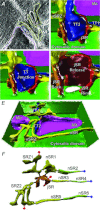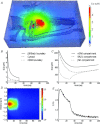Modelling cardiac calcium sparks in a three-dimensional reconstruction of a calcium release unit
- PMID: 22495592
- PMCID: PMC3477749
- DOI: 10.1113/jphysiol.2012.227926
Modelling cardiac calcium sparks in a three-dimensional reconstruction of a calcium release unit
Abstract
Triggered release of Ca2+ from an individual sarcoplasmic reticulum (SR) Ca(2+) release unit (CRU) is the fundamental event of cardiac excitation–contraction coupling, and spontaneous release events (sparks) are the major contributor to diastolic Ca(2+) leak in cardiomyocytes. Previous model studies have predicted that the duration and magnitude of the spark is determined by the local CRU geometry, as well as the localization and density of Ca(2+) handling proteins. We have created a detailed computational model of a CRU, and developed novel tools to generate the computational geometry from electron tomographic images. Ca(2+) diffusion was modelled within the SR and the cytosol to examine the effects of localization and density of the Na(+)/Ca(2+) exchanger, sarco/endoplasmic reticulum Ca(2+)-ATPase 2 (SERCA), and calsequestrin on spark dynamics. We reconcile previous model predictions of approximately 90% local Ca(2+) depletion in junctional SR, with experimental reports of about 40%. This analysis supports the hypothesis that dye kinetics and optical averaging effects can have a significant impact on measures of spark dynamics. Our model also predicts that distributing calsequestrin within non-junctional Z-disc SR compartments, in addition to the junctional compartment, prolongs spark release time as reported by Fluo5. By pumping Ca(2+) back into the SR during a release, SERCA is able to prolong a Ca(2+) spark, and this may contribute to SERCA-dependent changes in Ca(2+) wave speed. Finally, we show that including the Na(+)/Ca(2+) exchanger inside the dyadic cleft does not alter local [Ca(2+)] during a spark.
Figures






Similar articles
-
Increasing SERCA function promotes initiation of calcium sparks and breakup of calcium waves.J Physiol. 2021 Jul;599(13):3267-3278. doi: 10.1113/JP281579. Epub 2021 Jun 5. J Physiol. 2021. PMID: 33963531 Free PMC article.
-
Ca²+ spark-dependent and -independent sarcoplasmic reticulum Ca²+ leak in normal and failing rabbit ventricular myocytes.J Physiol. 2010 Dec 1;588(Pt 23):4743-57. doi: 10.1113/jphysiol.2010.197913. Epub 2010 Oct 20. J Physiol. 2010. PMID: 20962003 Free PMC article.
-
T-tubule disruption promotes calcium alternans in failing ventricular myocytes: mechanistic insights from computational modeling.J Mol Cell Cardiol. 2015 Feb;79:32-41. doi: 10.1016/j.yjmcc.2014.10.018. Epub 2014 Nov 6. J Mol Cell Cardiol. 2015. PMID: 25450613 Free PMC article.
-
An intelligent sarco-endoplasmic reticulum Ca2+ store: release and leak channels have differential access to a concealed Ca2+ pool.Cell Calcium. 2010 Aug-Sep;48(2-3):143-9. doi: 10.1016/j.ceca.2010.08.001. Epub 2010 Sep 16. Cell Calcium. 2010. PMID: 20817294 Review.
-
A review of recent insights into the role of the sarcoplasmic reticulum and Ca entry in uterine smooth muscle.Eur J Obstet Gynecol Reprod Biol. 2009 May;144 Suppl 1:S11-9. doi: 10.1016/j.ejogrb.2009.02.010. Epub 2009 Mar 13. Eur J Obstet Gynecol Reprod Biol. 2009. PMID: 19285773 Review.
Cited by
-
Modeling effects of L-type ca(2+) current and na(+)-ca(2+) exchanger on ca(2+) trigger flux in rabbit myocytes with realistic T-tubule geometries.Front Physiol. 2012 Sep 10;3:351. doi: 10.3389/fphys.2012.00351. eCollection 2012. Front Physiol. 2012. PMID: 23060801 Free PMC article.
-
Computational modeling of subcellular transport and signaling.Curr Opin Struct Biol. 2014 Apr;25:92-7. doi: 10.1016/j.sbi.2014.01.006. Epub 2014 Feb 7. Curr Opin Struct Biol. 2014. PMID: 24509246 Free PMC article. Review.
-
An integrated finite element simulation of cardiomyocyte function based on triphasic theory.Front Physiol. 2015 Oct 20;6:287. doi: 10.3389/fphys.2015.00287. eCollection 2015. Front Physiol. 2015. PMID: 26539124 Free PMC article.
-
Hierarchical approaches for systems modeling in cardiac development.Wiley Interdiscip Rev Syst Biol Med. 2013 May-Jun;5(3):289-305. doi: 10.1002/wsbm.1217. Epub 2013 Mar 5. Wiley Interdiscip Rev Syst Biol Med. 2013. PMID: 23463736 Free PMC article. Review.
-
A Stochastic Spatiotemporal Model of Rat Ventricular Myocyte Calcium Dynamics Demonstrated Necessary Features for Calcium Wave Propagation.Membranes (Basel). 2021 Dec 18;11(12):989. doi: 10.3390/membranes11120989. Membranes (Basel). 2021. PMID: 34940490 Free PMC article.
References
-
- Altamirano J, Bers DM. Effect of intracellular Ca2+ and action potential duration on L-type Ca2+ channel inactivation and recovery from inactivation in rabbit cardiac myocytes. Am J Physiol Heart Circ Physiol. 2007;293:H563–H573. - PubMed
-
- Asghari P, Scriven DRL, Hoskins J, Fameli N, van Breemen C, Moore EDW. The structure and functioning of the couplon in the mammalian cardiomyocyte. Protoplasma. 2011;249(Suppl 1):S31–38. - PubMed
Publication types
MeSH terms
Substances
Grants and funding
- 5P01HL46345/HL/NHLBI NIH HHS/United States
- 1R01 HL96544/HL/NHLBI NIH HHS/United States
- P41 GM103412/GM/NIGMS NIH HHS/United States
- R01 HL096544/HL/NHLBI NIH HHS/United States
- 1R01 GM31749/GM/NIGMS NIH HHS/United States
- R01 GM031749/GM/NIGMS NIH HHS/United States
- P41 GM103426/GM/NIGMS NIH HHS/United States
- 8P41GM103426-19/GM/NIGMS NIH HHS/United States
- RR004050/GM103412/GM/NIGMS NIH HHS/United States
- R01 HL105242/HL/NHLBI NIH HHS/United States
- P41 RR004050/RR/NCRR NIH HHS/United States
- P01 HL046345/HL/NHLBI NIH HHS/United States
LinkOut - more resources
Full Text Sources
Research Materials
Miscellaneous

